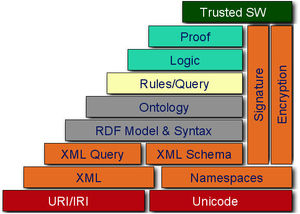 Image via WikipediaI have been looking at PopcornJS this morning. PopcornJS allows programmers to build in triggerable events in the code delivering a video in a webpage. What problems does that solve? One of the things we are wrestling with at the college is accessibility. According to ADA 508, all videos have to be captioned. We have grants for captioning videos. I have always thought that we should be doing more. If we follow the principles of Universal Design, we are not only making media accessible, but we are crafting learning modules and objects for their maximum interactivity and, what I feel is the next step, connectivity. Videos and other learning content represent another opportunity to link students to subject matter experts and other students. We can integrate learning modules with knowledge networks. One avenue of exploration is HTML5 and the semantic web. We can do more than just caption videos - we can take the metadata, the code in that accompanies the video and package it with a transcript of the video to trigger events and things like live links to Twitter, Flickr, Google Maps & Translate, Wikipedia, etc. PopcornJS is the code that will allow us to do this. There is an interesting page and demo on PopcornJS.
Image via WikipediaI have been looking at PopcornJS this morning. PopcornJS allows programmers to build in triggerable events in the code delivering a video in a webpage. What problems does that solve? One of the things we are wrestling with at the college is accessibility. According to ADA 508, all videos have to be captioned. We have grants for captioning videos. I have always thought that we should be doing more. If we follow the principles of Universal Design, we are not only making media accessible, but we are crafting learning modules and objects for their maximum interactivity and, what I feel is the next step, connectivity. Videos and other learning content represent another opportunity to link students to subject matter experts and other students. We can integrate learning modules with knowledge networks. One avenue of exploration is HTML5 and the semantic web. We can do more than just caption videos - we can take the metadata, the code in that accompanies the video and package it with a transcript of the video to trigger events and things like live links to Twitter, Flickr, Google Maps & Translate, Wikipedia, etc. PopcornJS is the code that will allow us to do this. There is an interesting page and demo on PopcornJS.This is what the internet should be doing. There are too many tools like this available for us to accept content from publishers that is not accessible. Publishers will often supply textbooks and supplementary content that does not meet ADA guidelines. Educators and instructional designers should be taking the lead in the colleges using techniques like PopcornJS and not waiting for the commercial publishers to catch up. They have no interest in meeting ADA guidelines because they are not the ones that have to deal with the consequences. In my quest to make the internet a happier, shinier place, I am not calling for a boycott of those companies but suggesting a solution. Colleges could pool their resources (programmers, beta-testers, and content creators) to help move this project along much in the same way the Sakai project is supported. The commercial uses for something like PopcornJS are obvious - someone looks up and watches a surfing video in YouTube. The video opens in a page with a map of the area where the video was filmed, a link to the TripAdvisor page on the area, the Twitter feed about the surf from the locals, and of course, more targeted marketing. But imagine taking that page as a teacher or instructional designer and building in other learning modules, maps, translations and connections.
Colleges should be setting the standards for media and the semantic web to, at minimum, ensure accessibility. We should go farther and develop guidelines for content around interactivity and connectivity. The semantic web and projects like PopcornJS represent another opportunity to open up education. What do we call these? Semantic knowledge guidelines?

No comments:
Post a Comment